A Snapshot of Linux Gamers, Just One Year Ago
It’s about time we share the analysis of that Q1 2016 survey (fielding occured in March last year), especially as we are about to launch the Q1 2017 one pretty, pretty soon. That way we will be able to compare how things have changed over the course of 12 months. As usual, the whole disclaimer about online surveys is valid here (data is only as good as your n size, the appropriateness of your sampling, and the quality of the responses, etc…), but assuming it’s not all that bad and all that unreliable, let’s dig in the results. As a reminder, most of the respondents for this survey were recruited through the r/linux and r/linux_gaming subreddits, as well as the readership of BoilingSteam. This is not our first survey, and you can see our previous ones done in the second quarter of 2015, and the following one in the last quarter of 2015.
Where the Wild Penguins Are
Location-wise, there was no real difference versus the previous surveys. It seems like the sample is very reproducible for that particular aspect.
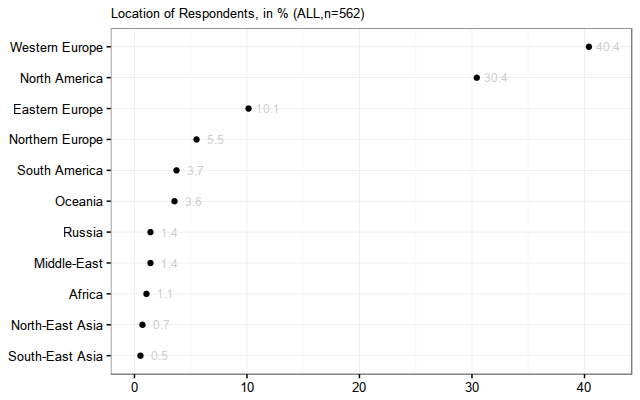
Please note that this does not mean that there are more Linux users in Europe than in the US - it’s certainly a possibility, but this result is certainly more likely to represent the linux gamers demographics in r/linux and r/linux_gaming communities.
As usual we see that respondents from Eastern Europe tend to be slightly younger than in Western Europe or North America, but this time the difference is not as drastic as the previous survey’s. There is probably not statistical difference between the true means of each group.
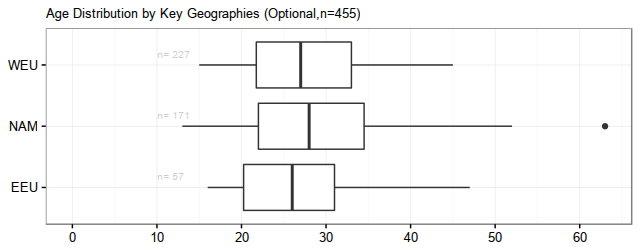
Giving a closer look at the density of the age distribution clearly shows a skew of the distribution towards younger respondents, and we can see it’s far from being a normal distribution shape-wise:

It also indicates that there may actually be two underlying groups inside that distribution: a younger age group whose peak is around 22 years old, and a second age group whose peak is at 31 years old. Maybe they represent some kind of peak of Linux usage in their respective generations? We would need to look at other variables to confirm such hypothesis.
I do have a theory though. Assuming that the second peak (the ones who are now 31 years old) got into Linux about 10+ years back, this would coincide very strongly with the release of the first few versions of Ubuntu (2004 and later). Since Ubuntu has become one of the most popular distribution, this would make a lot of sense.
Who Penguins Live With
The Family situation among Linux gamers shows some wide variations depending on the geography. As seen above the age distribution between North Americans and Western Europeans is not significantly different, yet the family situation tells a very different tale.
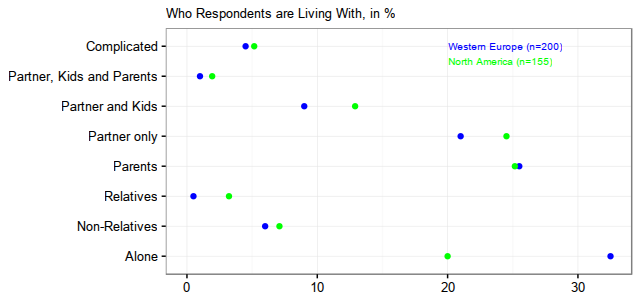
As you can see, North Americans are more likely to live with a partner, or a partner and kids vs their Western European friends - there is a clear gap when looking at folks living by themselves (“Alone”). Another clear difference among respondents is the fact that North Americans are somewhat more likely to live with Relatives (i.e. not their parents, but related family members) than Western Europeans. This is not the object of this survey, but one of the key drivers explaining such differences is that North Americans tend to get married and have kids earlier, sometimes much earlier than folks in Western Europe (the average age of women at first child certainly supports that hypothesis) - so that is why you should expect to see such differences between the two groups, while they are not so different age-wise.
Playful Penguins
While Desktop/Laptop gaming was by far the main platform, as expected, we can see there’s also 1 respondent out of 5 gaming on Mobile Phones, and a little less with Recent Consoles (anything above Xbox360/PS3).
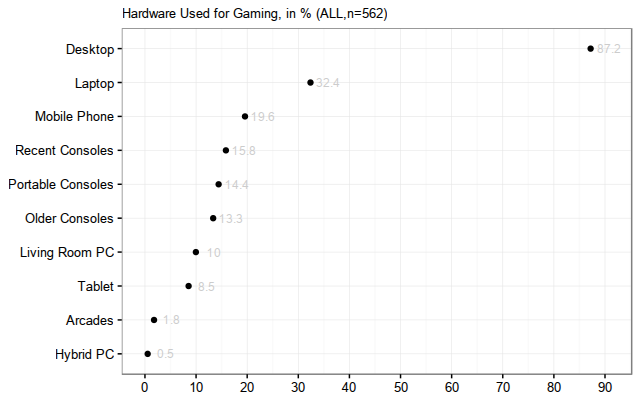
As a side note, it’s remarkable how mobile phones have grown to overtake Portable Consoles in just a matter of years. Even in Japan the change is obvious - folks who were seen before playing with their Sony PSP or DS have now switched to mobile phones for gaming on the go. And the Nintendo 3DS is really just for the niche market of kids gaming who don’t have a smartphone yet. Another point to take note of, the living Room PC is becoming more and more of a thing (10%), since most games can be played with controllers these days (especially since the advent of the Steam Controller) and that’s where you usually have the largest screen in the house/apartment.
As expected, almost 100% use Linux as their home Desktop OS of choice, while Windows usage is still relevant for a third of respondents (i.e. probably dual-booting).

So, what do respondents have at home running Linux ? While Desktop/Laptops are almost given, we were more interested to see what other hardware was running Linux as well.
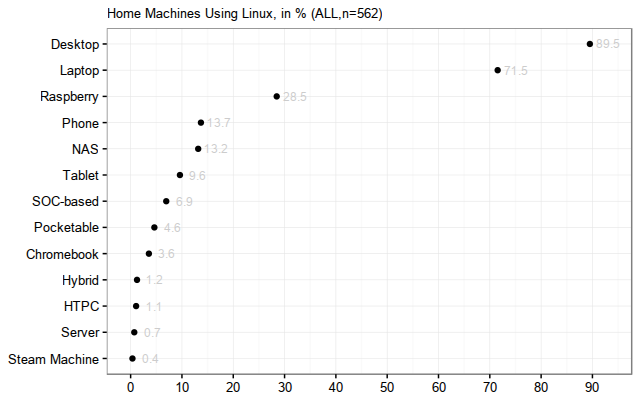
Once again the ratio of Raspberry Pi finding an owner is pretty amazing. Almost a third of respondents have a Raspberry Pi, and more than a third if you consider SOC-based hardware. Chromebooks are still somewhat of a rarity in this community, with less than 4% ownership. This tends to confirm that Chromebooks users are probably more likely to be kids or students than the regular Linux crowd.
Right now I am not sure what to make of the Phone/Tablets results. While specifically mentioned that these categories were about Ubuntu Phones and tablets mostly, I am convinced that a lot of respondents assumed that a device running Android can also fit the description - that, or Ubuntu as a phone/tablet OS had way more usage than previously thought. Doubtful.
On a different level, we can sadly confirm that Steam Machines represent a very small fraction of the user base. Not very surprising, when there was close to no marketing effort from anyone around it.
Unsurprisingly, the majority of Linux Gamers (57%) have been gaming on the platform only for a short time, i.e. less than 3 years. You can certainly find much more experienced Linux gamers (who probably started with the Loki ports, or who knows, Quake or Doom back in the days!) but it’s undeniable that Valve’s efforts to support Linux have made people game more on the platform in recent years:
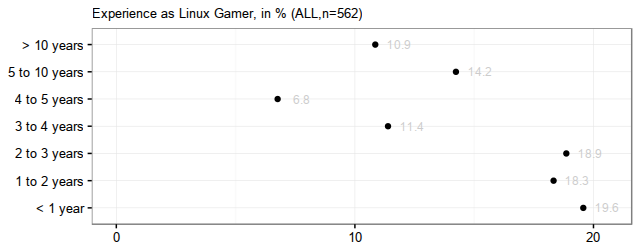
We should take note that the growth (new users) even in the past year before this survey seems to be far from negligible (close to 20%). There was an additional question relevant to the choice of Linux as a gaming platform, and while it’s very much qualitative due to the number of actual answers for that question, among the ones who started gaming on Linux recently (less than one year), the issue of “Windows 10” came very clearly over, and over again. Some complaining about the forced upgrade, others about the privacy dark patterns employed by Microsoft. A couple of comments directly from respondents:
The revelations of Windows 10’s (lack of) privacy policies. I had gamed on Linux before, be it through Wine and some native games 5 or so years ago, or in the last 3 years when Steam launched on Linux, but I only got deep into it when I fully switched to Linux almost a year ago.
And…
Windows 10 spyware, and the increasing surveillance and tracking on the internet in general made me want more control over what my OS is doing to reclaim some of my lost privacy. I went from dabbling with various Linux distros and FreeBSD as a hobby on secondary PCs to using Arch Linux as my only operating system in october 2015.
Now when it comes to the next question regarding the main device using for (Linux) Gaming:

Nothing very surprising here, but one could notice the emergence of DIY Steam Machines, i.e. Living Room PCs running SteamOS. While the Steam Machines did not sell well by any standard, at least SteamOS seems to have picked up a following, even if it’s still a minority of users among Linux gamers. Other Living Room PCs indicated here are not running SteamOS. Overall we are talking about 5% users here using a Living Room PC (SteamOS or not) as their main gaming machine.
Another question seems to confirm this extended use of SteamOS - when asked what Linux distro was their main one for Linux gaming:
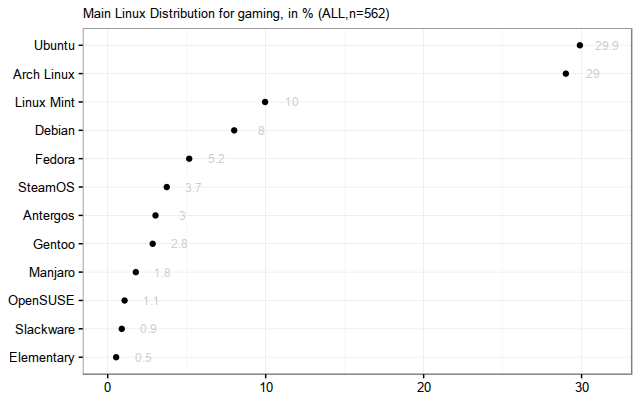
SteamOS showed up as 3.7%, which is consistent with the previous question, and the previous survey (Q4 2015) as well. The key difference that time was the position of Debian vs Fedora. In the previous survey they were at about the same level of usage while there is now a slightly larger gap in favor of Debian. Once again, due to the nature of surveys, there is always a margin of error that is expected from one evaluation to the next (sampling error).
Penguins and their GPU pets
While the overall ratio of GPU brands used for Linux gaming machines is not very different from before, there is this time around an increased amount of respondents using AMD and Intel. Unless we see such evolution again and again in the future, I would assume this is simply due to the variability of the sample (there’s most likely between 5 and 10% margin of error at 95% CI).

The Intent to Upgrade hardware in 2016 showed that there was still a non-negligible portion of respondents who considered hardware upgrades (actually 44%) at that point in time.
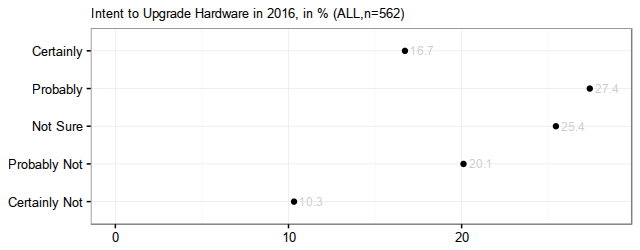
What’s more revealing, however, is the split of upgrade intent (Top2 box - certainly and probably) between current owners of nVidia hardware (35%) and AMD hardware (52%). About one AMD Linux gamer out of two was thinking about changing hardware!
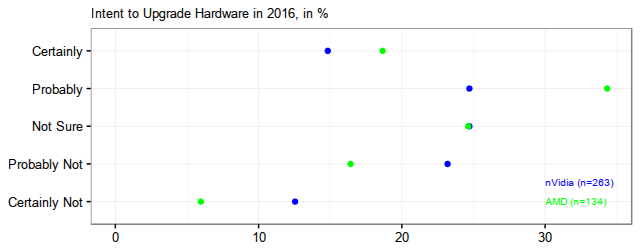
Of course, we don’t know for WHAT brand they were planning to change to. But this disparity among the brands is certainly not random, based on what we knew at the time about AMD cost/performance ratio on Linux machines - and the different complaints about glitches and various bugs with the proprietary drivers. In 2016, if you only cared about gaming performance, AMD was unfortunately still behind, and it could be that the growing availability of games combined with sub-par performance on AMD led more AMD users to consider upgrading or switching.
It will be interesting to see how things have changed in early 2017 since AMD has made major progress both in the driver space and the cards offering with the RX480.
Now, coming back to nVidia, while the sample is limited to folks who voluntarily declared with graphics cards they where using, one can see that powerful GPUs seem were relatively abundant. It was kind of shocking to see that more than a third of nVidia owners possessed a GTX970 or better (GTX 970, GTX 980, GTX 980 Ti) card.
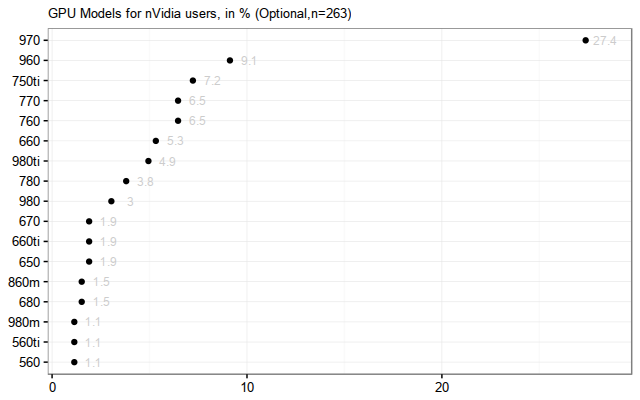
The above graph does not compute to 100% since there were many other exotic cards used by only one-two folks that are not shown up here. So the above represents 75% of the nVidia cards disclosed.
If you group that 75% of GPU cards by categories (lower range, medium range, higher range) of performance, you get this kind of picture… (based on benchmarks established across all ranges of nVidia models - in this particular case the High performance tier is comprised of GTX780,970,980,980Ti - the medium thier has GPUs like GTX670,680,760,770,960).

So what does this mean ? While there were plenty of Linux gamers back in 2016 who apparently had pretty high-end GPUs (among nVidia owners), it was not the majority. So if your game/port did run poorly on anything that was not high end, you may have been losing quite some chunk of your audience (namely up to about 40%, potentially).
Where Penguins Fish
We can also look at the different channels for games distribution. Resellers and the usual suspects.

The “Ever-Usage” of Resellers is like clockwork. The results from Q1 2016 are almost identical to the previous survey, which seems to indicate that such figures are pretty representative of the overall population among the r/linux and r/linux_gaming communities. This also means that GOG was not really progressing in gaining any kind of meaningful new users. Steam reigned as a king still, concentrating most of the games purchased across all stores. I’d like to see GOG as a stronger competitor but sadly they are VERY far from being there yet. And still no GOG Galaxy client for Linux. Still the SAME situation in 2017. Sigh.

When looking at which resellers were used in the past month at the time of the survey, the key difference vs the previous survey was the position of Third Party Resellers - they used to be higher than GOG, while they were used very little in that timeframe. How to explain that? Well, third party resellers usually work by “spikes” - they get lots of users when they happen to have very good deals, but otherwise gather few recurrent, regular gamers, despite the massive amount of spamming they do. Stores like Steam, HB and GOG do not face the same kind of issues as they act as the end-distribution channels as well as resellers.

All in all the results in terms of satisfaction for each channel were very consistent from one survey to the next:
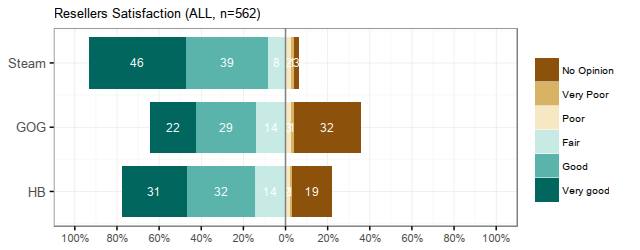
The “No opinion” category usually comes from folks who are not using such services or not using them enough to rate them. What matters then is the proportions among the other answers - we can see that the level of “very good” satisfaction is relatively low for GOG compared to the others, and Steam is clearly leading the Satisfaction aspect of things. It’s unlikely that any actor disrupts the market anytime soon: Steam has the highest share and the highest rate of satisfaction - usually things are expected to change when there is a market leader causing frustration and letting the situation rot, but Steam has not yet reached this stage.
While DRM is still a hot topic in the Linux community (Denuvo in games, for example), the prevailing attitude is that most respondents don’t feel bothered enough to reject them completely, while they clearly don’t like them (86%). Only a minority (13%) seem to care enough to avoid DRM’ed games.

As a side note, when a Windows game uses Denuvo, it is usually impossible to run it on Linux using WINE. This was recently the case with Doom 2016, until the game was finally cracked and the Denuvo DRM removed according to the binding contract regarding the protection. Once it was removed, Doom 2016 was able to run on WINE properly.
Penguins’ Gaming Habits
Most Linux gamers were not exclusively gaming on Linux. Pretending the opposite would be dishonest, and there are plenty of proof that Dual-Booting is very much a thing, as well as gaming on other platforms. This being said, we can say that most Linux gamers played mostly on Linux if we believe how respondents answered that question (72.6% mostly or exclusively on Linux).
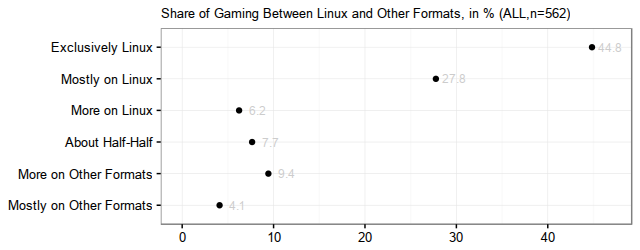
This becomes a lot more interesting when we split the data according to the experience of Linux gamers (i.e. newer Linux gamers versus Linux gaming veterans). New Linux Gamers are defined as gaming on Linux for less than 2 years, Long term Linux gamers for more than 4 years, and Less New Linux Gamers just in between.
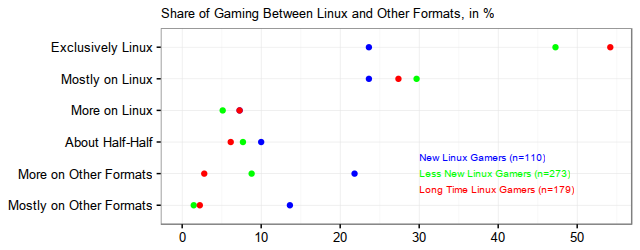
The more experienced gamers on Linux showed a massive skew towards exclusively gaming on Linux (54% for Long-Time Gamers!) while Newer Linux Gamers are only at about 23%. This seems to indicate that the longer you play on Linux, the more you are likely to quit playing on other platforms, or at least massively reduce your playtime on those. I guess it becomes a virtuous cycle: you first give it a try, you start playing more and more with it, and before you realize it you kind of stop booting into Windows or playing on consoles. We have also heard recently from Edwin (Feral Interactive) that the “growth (in volume) of Linux gamers has been quite nice” since they started porting games for Linux. All of these pieces pulled together make for a very consistent story.
Now we can put some numbers of what we have seen qualitatively when folks mentioned “they stopped dual-booting”, for example, or “erased my Windows partition”. This is certainly happening and it does not seem to be an isolated phenomenon.
Another funny consequence of being a “new Linux Gamer” could be seen in the choice of GPU brands:

Newer gamers were much more likely to be using AMD GPUs, while more experienced gamers “know better” at more than 70%. Note that there were still a bit more than 20% of the more experienced Linux gamers who decide to go for AMD, probably for very specific reasons (better open source drivers, dislike of nVidia business practices, etc…).
There’s another way to look at the data. Instead of looking at how long folks have been playing on Linux, we can look at the desktop usage. Between the ones who use Linux as the single Operating System on their desktop versus the ones who keep Windows or OSX for various reasons, the ratio changes dramatically. See for yourselves:
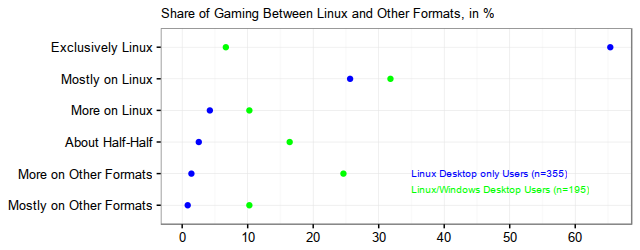
This echoes very nicely what our friend Cybik mentioned in our podcast with him: “If you want to make Linux Gaming grow, you need to grow Desktop Linux first”. Indeed, 65% of those using Linux as their only Home OS play exclusively on Linux ! Note that this is NOT an obvious insight, since Linux gamers could be playing on non-PC formats as well (consoles, mobile phones, tablets) if they chose to.
Hungry Penguins
This time around we added a bunch of questions regarding gaming habits and spending. The Frequency of Games Purchases on Linux followed the below distribution, showing that a majority of Linux Gamers seemed to be frequent purchasers (57% buy games at least once a month).
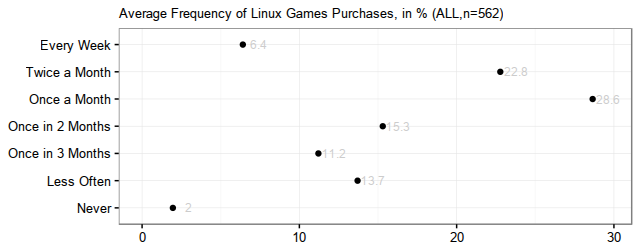
The budget allocated to Games on Linux varied greatly however, with 75% of respondents spending at least less than 30 USD per month (50% between 15 and 30 USD). There were many outliers though…

Comparing the two main locations, there were actually some difference in the median values. Linux Gamers in North America may be spending more than Western European Linux Gamers.
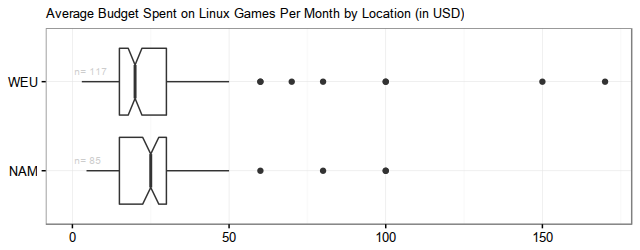
How much more ? well, the median showed a difference of 5 dollars (20 for Western Europe, 25 for North America). Since the North American market may also be a bigger one, this seemed to indicate that it may also be the most profitable.
It’s worth doing a couple of estimations as well - Among the ones who answered about their monthly spending (n=294), we get on average about 26 USD. Assuming we have about a million and a half of regular Linux gamers, and that the folks who answered this survey tend to represent the most active part of the community/spending (the 80/20 rule, this representing the 20% but accounting for 80% of total spending), can we guess roughly how large is the market spending on a yearly basis ?
1 500 000 * 0.20 * 26 * 12 = 140 M
As mentioned this could be taken as being the 80% of total spending (assuming there are a bunch of gamers on Linux who are way less active), and the total yearly spending of the Linux gaming community could be around 175 M USD.
How good/bad is this estimate ? Knowing that Valve was probably getting somewhere around 1.5 Billion USD in sales, and that has number should have grown probably up to 4 or more by now following the usual estimates (revenues were apparently around 3.5 B USD in 2015) and growth estimates they have shared at the latest steam days, 0.175/4.0 gives us about 4.3% of the total revenue of Steam coming from (1% user base) of Linux users. There are now a couple of possibilities:
- Linux users are fewer in user base, while they buy more games on average and represent more of the total percentage in revenues. This is something that’s consistent with the HB sales, while we have no idea if that’s the case on Steam or anywhere else.
- Our estimation of the total revenues of Steam is completely off and they may be earning a lot more than 4 Billion USD in 2016. Who knows?
- Our estimation of the total revenues coming from Linux gamers is off by a bit, and actual spending from the Linux community is lower (100M USD ? 70 M USD ?). Well this is very likely, since this is a massive guesstimate.
We will not know the truth at this stage, but I get the feeling that this figure is not completely off. Hopefully in the next survey we can see if the 26 USD average is any consistent or not, and revise the estimate accordingly and see if we can use other metrics to derive better estimations too.
Penguins Exploring the Steam Universe
Once again we confirmed that the ownership of Steam Controllers was pretty high in these communities. 1 gamer in 4! It seemed to be rather stable then with few people claiming to order new ones at this stage. Next time I will add a specific question about the controllers used for modern games, to compare the ratio of ownership and usage of Xbox360, PS3/PS4 pads and the like.
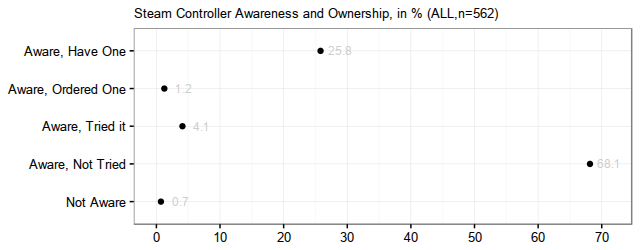
As for the Steam Link, the awareness of its existence was very high, but its ownership, not so much, around 4%. There is definitely a market for it, but its usage remains probably limited to the folks who have larger houses and multiple screens they would like to make use of at low cost. I guess most folks play on a single computer, at least in this community.

Regarding Steam Machines, there is an interesting disconnect between the fact that most respondents seemed to like/really like the idea overall (72%) while there’s very few who actually bought one (1.2%). The usual “yeah, I am sure it’s great for other people, but I don’t really need it”.

And this, despite the fact that the awareness is very high (99%). Note that the ownership of Steam machines has hardly progressed since the previous survey - which is hardly surprising since the offering has not evolved that much, and there is virtually no marketing for it.
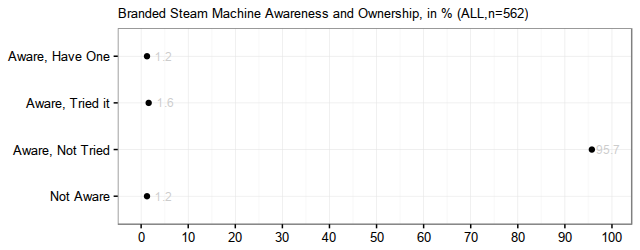
We can dig further in different brands of Steam Machines, and look at key differences between the models from the different manufacturers.

Overall Alienware is clearly winning the awareness battle, but it did not result in a much higher rate of ownership versus Syber or Zotac.


We know that Steam Machines were not so hot then, and it could very likely have been linked with their pricing. A large majority of respondents (about 72%) would expect a maximum of 600 dollars for a Steam Machine, yet most of the options out there were relatively pricey (the Zotac Nen is definitely out of that price range).
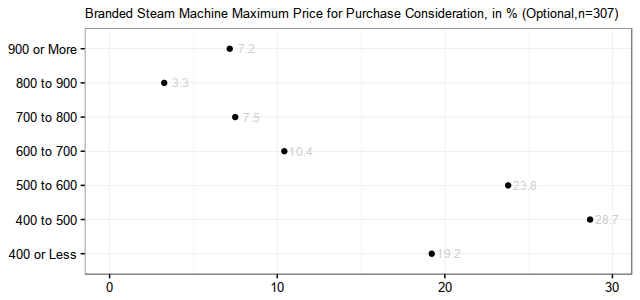
It is indeed disappointing that everything that has come out for Steam Machines kind of target the medium to expensive range only, without considering at all that low-cost solutions may be interesting solutions as well for gaming. In 2017 it should become possible to make DIY Steam Machines with AMD hardware at much reduced costs (Ryzen + AMD GPU) so integrators should be able to make prices go down as well for living room PCs.
Penguins Play For Hours and Hours
One new question introduced in this survey was about the duration spent playing on a typical week. Your median player used to spend about 13 hours per week (not bad!) with 75% of respondents spending up to 20 hours per week. The rest were playing a lot longer, and there were a bunch of outliers who played way, WAY more. 80 hours a week, yeah dude! It’s like 2 full-time jobs!

Is there a lot of difference in gaming hours between employed folks and students for example ? The data seems to provide a good answer.
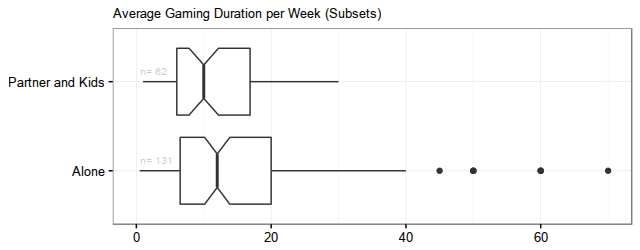
There is not a large difference on the median, but there is a clear difference of spread - at maximum the ones living with Partner and kids play for 30 hours per week, while those living Alone face no such restrictions and their upper limit goes to 40 hours per week (and way higher if we consider the outliers).
A much better explanation for the actual time spent on a weekly basis on games is… whether folks considered themselves hardcore gamers or not (we had a question for that). When looking at such angles, the data splits very nicely with very significant differences in medians.

We can now say that, according the the results:
- Most (75%) Casual gamers spend less than 10 hours gaming per week.
- Most (75%) Neutral (in-between) gamers spend less than 18 hours gaming per week.
- Most (75%) Hardcore gamers spend MORE than 17 hours gaming per week!
What Penguins Read
The main source of information for gaming news was the r/linux_gaming subreddit. This is kind of super biased since we sourced most of our respondents from there, so… not sure if it’s really reliable. Then of course you could expect to find GOL (they certainly have a large number of news) followed by BoilingSteam (far behind to be honest). It will be interesting to see if the situation has changed or not in 2017. Among more generalist sites, Ars Technica was apparently more frequently consulted than Softpedia or PCWorld.

Since 2016 there has been no new Linux-dedicated websites popping up. As the market grows it will be interesting to see if that part of the market grows as well. It should. When there is a market, there is media as well.
What we learnt so far
Let’s do it bullet-point style.
- There’s a healthy growth in newcomers to Linux gaming every year, about 20% of the whole Linux gamers surveyed.
- Exclusive Linux desktop users are very likely to be/become Exclusive Linux gamers, too.
- About 70% Linux gamers play “mostly” on Linux.
- Experienced Linux gamers tend to clearly favor nVidia rather vs AMD.
- About 40% of nVidia users may have high-end GPUs.
- Hardcore Linux gamers spend a lot more time (3x more) gaming than casual gamers.
- Linux gamer average spending is about 26 USD per month (give or take).
- Revenues coming from Linux gamers may be in the hundred of million USD per year. I said maybe. Don’t quote me OK ?
- SteamOS runs a lot more often on DIY Steam Machines than Branded ones.
- Alienware is moderately more successful than any of the other Steam Machines makers.
- Steam Machines’ opportunity may lie in the lower price range (less than 500 USD ideally).
- Steam remains the main channel for Linux gamers to purchase games, and enjoys quite high user satisfaction.
- About 1 Linux gamer out of 4 seems to have a Steam Controller already.
- The Steam Link and the Steam Machines failed to find any kind of market among Linux gamers.
Is there anything else we have missed? Let us know if you’d like us to look at the data from a different segment/standpoint.
Releasing Penguins’ Data in the Wild
As already mentioned a couple of weeks back, we are making the raw data available for the first time, at least for all the respondents who agreed to do so (that’s roughly 70% of them). The data is now available on this github account, as well as on Kaggle. You can feel free to use it to conduct your own analyses. I hope it can serve as a useful dataset as well for students or practitioners of Data Science looking for something to have fun with.
Thinking Ahead
The next survey will still feature a bunch of similar metrics, but we will also remove some of the questions related to Steam Machines since the market has not really changed, and there are about no marketing efforts to sustain them. Instead, we will focus a little more on games, and what Linux gamers would like to see. That should prove insightful. We will certainly try to release the next results in a much more timely fashion. If you are not a regular reader of BoilingSteam and want to make sure to take part in the upcoming survey, consider registering to our RSS feed or our newsletter. And if you want to motivate us to do more on surveys, there’s always Patreon folks!
